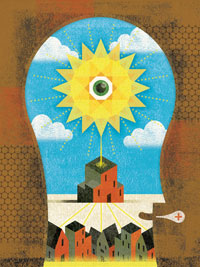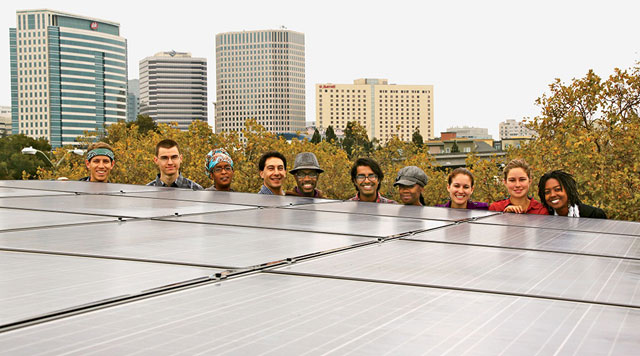sierraclub.org - sierra magazine - jan/feb 2013 - solar for all
Until now, rooftop solar has only worked for those with hefty electric bills and sunny roofs. Community solar could make it available to everyone.
By Paul Rauber
 Gordon Studer
Gordon Studer
I really wanted the figures to work out. So did Ricky, the nice young guy from Sungevity who was trying to lease me a solar array for my roof. My family was looking into a 1.7-kilowatt system—the smallest available. Even so, our miserly habits kept us firmly in our utility's lowest—and cheapest—tier of electricity usage. Solar is getting cheaper fast, but the numbers for the popular lease-financing model wouldn't pencil out unless we could somehow boost our energy usage into a higher tier.
"How about a plug-in Prius?" Ricky suggested helpfully. "That would make it work."
Unfortunately, even though a Prius driven 30 miles a day would increase our electricity use by 165 kilowatt-hours a month, a new car isn't in our budget—and so (for the time being, at least), neither are solar panels on our roof. That puts me in good company: Some 75 percent of Americans rent, live in condos, have roofs shaded by trees or other buildings, or are otherwise poor candidates for sun power. Which leaves us out of the clean energy revolution that's going on across the country.
If "revolution" sounds like hyperbole, consider this: U.S. solar installations more than doubled from the second quarter of 2011 to the second quarter of 2012. Last August, California's utility-scale solar plants hit 1 gigawatt—as much energy as can be generated by a large coal- or nuclear-fired power plant. Less remarked on during the celebration of that milestone was the fact that at the same time, "distributed solar"—the thousands of rooftop systems in the state—was exceeding that number by 20 percent, producing 1.2 gigawatts. In 2008, the National Renewable Energy Laboratory put the annual technical potential of rooftop solar in the United States at 819 trillion watt-hours, equal to about a fifth of the nation's 2011 electricity demand.
 Working through Mosaic, 70 community members financed this 8.6-kilowatt solar project on top of West Oakland's People's Grocery, which will save the food-justice project $32,000 over the next 20 years. | Photo courtesy of Mosaic
Working through Mosaic, 70 community members financed this 8.6-kilowatt solar project on top of West Oakland's People's Grocery, which will save the food-justice project $32,000 over the next 20 years. | Photo courtesy of Mosaic
Along with the increase in capacity, solar prices are plummeting, thanks to technological advances and fierce competition from China. Within two to three years, says John Farrell, senior researcher at the Institute of Local Self-Reliance in Minneapolis, both California and New York will achieve "grid parity." That's the golden moment when power from the sun becomes as cheap as average residential electricity. Hawaii is already there; in Honolulu, 41 percent of building-permit applications these days are requests to install solar systems.
"The economics continue to drive solar forward," Farrell says. "But there's still a big barrier. The economics are going to allow a stampede of folks who are well placed financially, and in terms of the property they own, to go solar. But it's leaving everyone else out."
So, what if I don't want to be left out? Couldn't I get together with the other 75 percenters in my neighborhood, put some solar panels on the local recreation center, and reap the benefits?
"Community solar happens for innovative citizens but always against the odds."
Many other people across the country are asking the same question—and some are succeeding in establishing a form of "community solar" or "solar garden." In Minnesota, members of the Wright-Hennepin Cooperative Electric Association can own part of a 39-kilowatt array of locally made panels on the roof of the co-op's headquarters, allowing them to share in the electricity just as they would with a system on their own roofs. California's forward-looking Sacramento Municipal Utility District lets customers purchase solar power from a local "solar farm," receiving the same full retail credit per kilowatt-hour that they would from a home system. And in Washington State, members of the nonprofit Backbone Campaign can invest in a 50- to 66-kilowatt solar array erected at a recycling transfer station, with a forecast return of 13.5 percent a year until 2020.
Nice for them, but not so much for me and my neighbors on Oregon Street. Our utility is of the big for-profit, investor-owned sort, not a cooperative, and I am neither a Washington resident nor a member of the Backbone Campaign, which means I'm prohibited by financial regulators from participating in its program. However good an idea community solar might be, achieving it requires surmounting a daunting string of institutional hurdles. "Community solar happens for innovative citizens," Farrell says, "but always against the odds."
Let's look at the obstacles facing my dream community solar project. For starters, my neighbors and I would need some capital, but banks aren't much interested in financing penny-ante solar arrays. Our numbers wouldn't look very good anyway, because a still-essential ingredient in solar's success is the 30 percent federal tax credit, and as a nonprofit, we wouldn't be able to take advantage of it.
If we somehow did manage to scrape together the installation money, we'd need to sell the juice our panels generated to our local utility. But what would be in it for them? Even in a state like California, where utilities are obligated (up to a point) to accept new residential solar applications, nothing requires them to deal with the Oregon Street Cat Fanciers' Solar Co-op. If they did, they'd have to come up with a billing system that would credit me and my neighbor Doris and the cat lady down the street proportional to our stakes in the project—something Pacific Gas and Electric Company (PG&E) has zero motivation to do.
In short, the chances of our plucky little neighborhood powering its blenders, DVRs, and iPads with shared solar look very poor. To triumph against the odds, community solar needs a model that can work within the current regulatory system (unhelpful as that may be) and that is widely replicable. Happily, two organizations (at least) appear to have such a model: Colorado's Clean Energy Collective and California's Mosaic.
Paul Spencer is founder and president of the former. He got into community solar after trying to design a "net-zero" community of 89 homes in Carbondale, Colorado, that would draw its power from a centralized solar system. The housing market collapse killed the project, but Spencer and his group resolved to craft a widely deployable model for community solar. It took a year and a half of running the numbers on dozens of different options before they settled on the rather uncollective formula of individual ownership.
1 | 2 | 3 | next >>